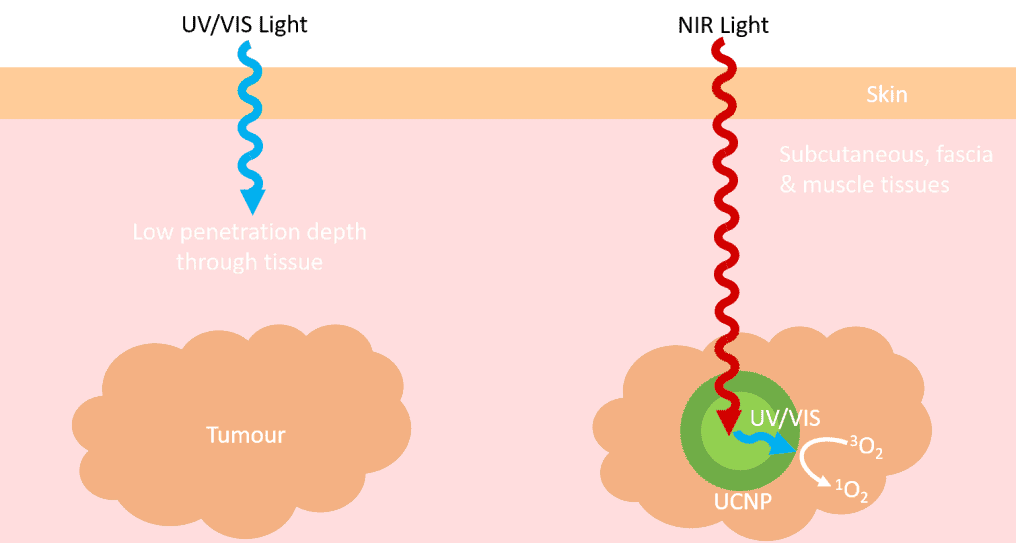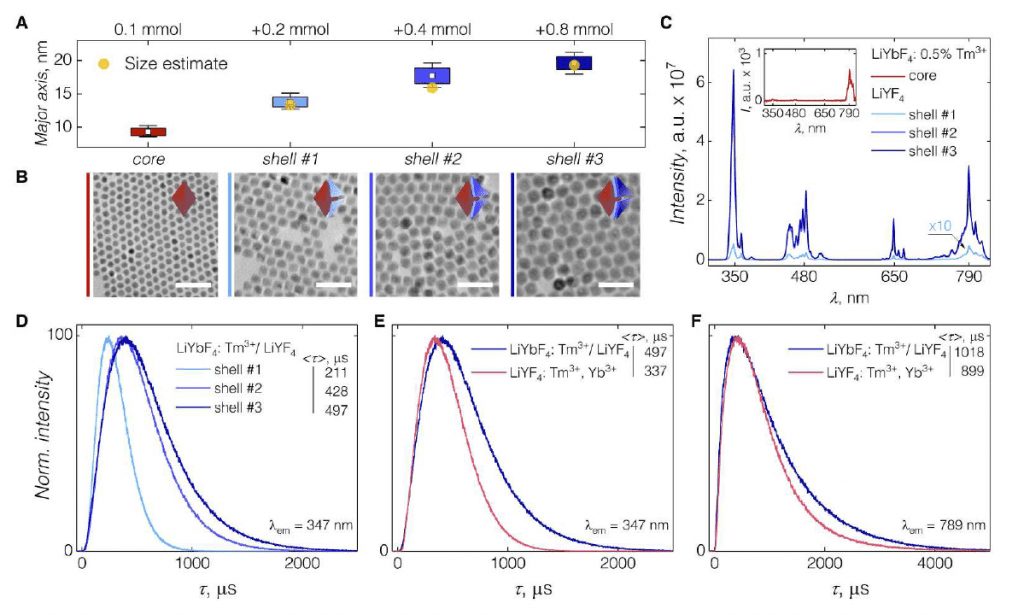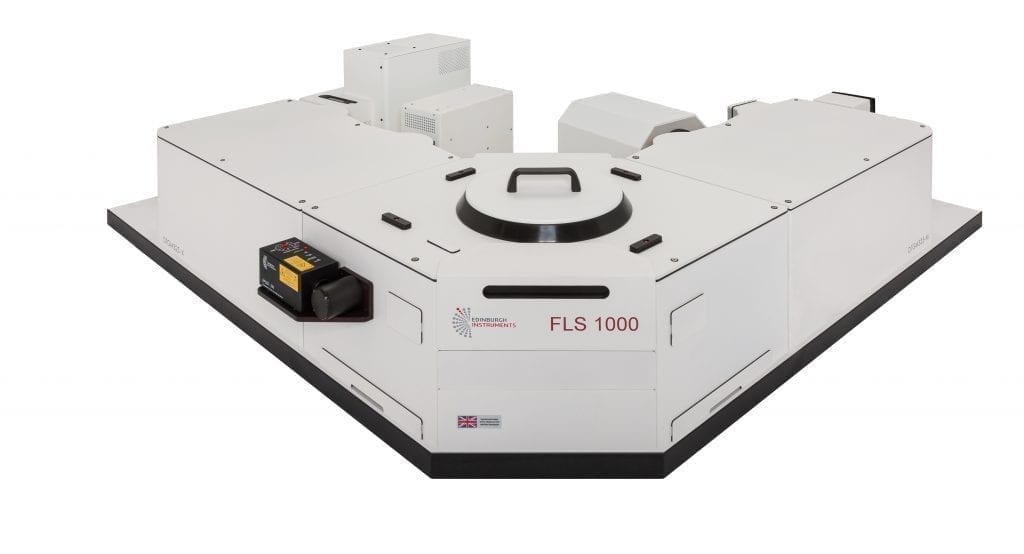Publication Highlight: Upconverting Nanoparticles (UCNP) for Photodynamic Therapy Treatment of Tumors
We wish to congratulate Professor Fiorenzo Vetrone and his research team at the Institut National de la Recherche Scientifique, Université du Québec for the publication of their paper “Small and Bright Lithium-Based Upconverting Nanoparticles (UCNP)” in JACS.¹
In this paper a new synthesis route for small and efficient upconverting nanoparticles was reported and their properties optimised with the aid of an Edinburgh Instruments FLS980 Photoluminescence Spectrometer. In this research highlight, the significance of Prof. Vetrone’s work and the photoluminescence techniques that they used to characterise their newly synthesised UCNPs are discussed.
One method to treat cancerous tumours is to use photodynamic therapy (PDT). In PDT a photosensitising agent is injected into the bloodstream or applied topically to the skin and over time the photosensitising agent preferentially gathers inside the cancerous tumour. The tumour is then exposed to light using a laser or LED source, and the photosensitising agent converts triplet oxygen (³O2) to reactive singlet oxygen (¹O2) which attacks and kills the cancerous cells. The main advantage of PDT is that the effect is highly localised with minimum damage to the surrounding healthy tissue, in contrast to treatments such as chemotherapy and radiotherapy. The drawback of PDT is that light must be able to reach the tumour which severely limits the range of cancers that can be treated. The photosensitising agents used in PDT require high energy UV or visible light in order to generate singlet oxygen. However, the penetration depth of these wavelengths of light through skin and tissue is only around 1 cm.² This limits the use of PDT to cancerous tumours on or just under the skin such as skin cancer; or tumours on the lining of internal organs such as esophageal cancer where a fibre optic endoscopic can be used to deliver the light. For tumours deep inside the body, PDT is not currently suitable.

A solution to this problem, that researchers such as Prof. Vetrone are investigating, is to use upconverting nanoparticles (UCNP) for PDT. In upconversion, long wavelength light is converted into shorter wavelength light either through multiple photon absorption or sequential energy transfer mechanisms. Upconversion is an attractive mechanism for improving PDT as longer wavelength light has greater penetration depth into tissue, potentially enabling deeper tumours to be treated. The principle of PDT using UCNPs is shown in Figure 1. First, UCNPs coated with a photosensitising agent are injected into the bloodstream and gather inside the tumour. The tumour is then illuminated with long wavelength near-infrared (NIR) light which can penetrate deeply through tissue. The UCNPs upconvert this NIR light into high energy visible or ultraviolet light which activates the photosensitisers coated on the outside of the UCNPs, resulting in the generation of singlet oxygen and destruction of the tumour.
A promising UCNP design is Tm3+ ions doped into a lithium host matrix of LiYbF4, where the upconversion arises through energy transfer from the Yb3+ to the Tm3+ ions. Previous studies into lithium host matrix based UCNPs have predominately involved UCNPs with sizes of greater than 80 nm. Such large nanoparticle sizes are problematic for in vivo applications such as PDT as the UCNPs must be small enough to be internalised by cells. In their JACs paper Vetrone et al. aimed to overcome this shortcoming by optimising the synthesis of small and efficient lithium host matrix UCNPs.
To achieve a UCNP that is simultaneously small and bright Vetrone et al. found that core shell structures were the key. In a core shell structure the active core of the UCNP is surrounded by an additional active or passive shell in order to supress surface quenching and improve upconversion yields. Vetrone et al. found that LiYbF4:Tm3+ cores surrounded by a passive shell of LiYF4 gave the best results and optimised the shell thickness using steady state and time-resolved photoluminescence spectroscopy. The photoluminescence emission spectrum of the UCNP when excited at 980 nm is shown in Figure 2C where the tremendous upconversion efficiency enhancement between core only (red trace inset) and core shell UCNPs (blue traces) can be clearly seen. Figure 2C also shows that the photoluminescence intensity increases as the shell thickness is increased from 2 nm to 4 nm to 5 nm. In order to further investigate the influence of shell thickness of the photophysics of the UCNP, Vetrone et al. used an Edinburgh Instruments FLS980 to measure the lifetime of the upconversion emission, which is shown in Figure 2D. The UCNPs were illuminated with a pulsed 980 nm laser and the 347 nm upconversion lifetime measured using single photon counting multichannel scaling. Increasing the shell thickness from 2 nm to 4 nm (traces #1 and #2) results in a substantial increase in photoluminescence lifetime from 211 μs to 428 μs, indicating a strong suppression of non-radiative recombination pathways with the thicker shell. However, it can be seen that increasing the shell thickness further to 5 nm (trace #3) offers only a small additional improvement in non-radiative recombination suppression. Given the need to keep the UCNP small for in vivo applications, it can be concluded from the photoluminescence lifetime measurements that a 4 nm shell is optimal.

In summary, this work by Vetrone et al. has established a new synthesis route and core shell design for small high efficiency UCNPs and demonstrates the power of photoluminescence spectroscopy in the optimisation of these materials and the establishing of structure property relationships.
For more information on this work, download the full paper from JACS.
References
- Ting Cheng, Riccardo Marin, Artiom Skripka, and Fiorenzo Vetrone, Small and Bright Lithium-Based Upconverting Nanoparticles, J. Am. Chem. Soc. 140 (40), pp 12890–12899 (2018)
- https://www.cancer.gov/about-cancer/treatment/types/surgery/photodynamic-fact-sheet
Upgrade of FLS980 to FLS1000 for Upconverting Nanoparticles (UCNP)
 A new synthesis route for small and efficient upconverting nanoparticles was reported, and the FLS980 Photoluminescence Spectrometer was used to optimise their properties. Since the discontinuation of the FLS980, Edinburgh Instruments has introduced its successor, the FLS1000 Photoluminescence Spectrometer. Featuring higher resolution, faster measurements, and increased automation, the FLS1000 sets the standard in both steady state and time-resolved photoluminescence spectroscopy for fundamental research and routine laboratory applications.
A new synthesis route for small and efficient upconverting nanoparticles was reported, and the FLS980 Photoluminescence Spectrometer was used to optimise their properties. Since the discontinuation of the FLS980, Edinburgh Instruments has introduced its successor, the FLS1000 Photoluminescence Spectrometer. Featuring higher resolution, faster measurements, and increased automation, the FLS1000 sets the standard in both steady state and time-resolved photoluminescence spectroscopy for fundamental research and routine laboratory applications.
For more information on the FLS1000, contact a member of our team at sales@edinst.com.
Stay in Touch
If you have enjoyed reading about this research, and would like to be the first to see all the latest news, applications, and product information from Edinburgh Instruments, then sign-up to our infrequent newsletter via the red sign-up button below, and follow us on social media.








